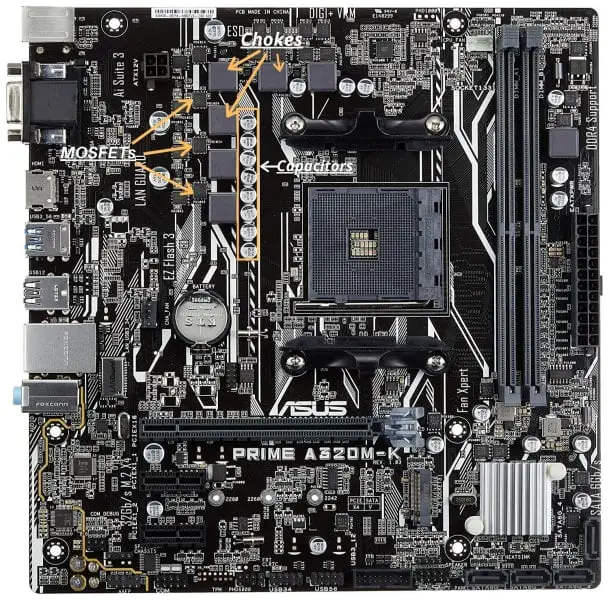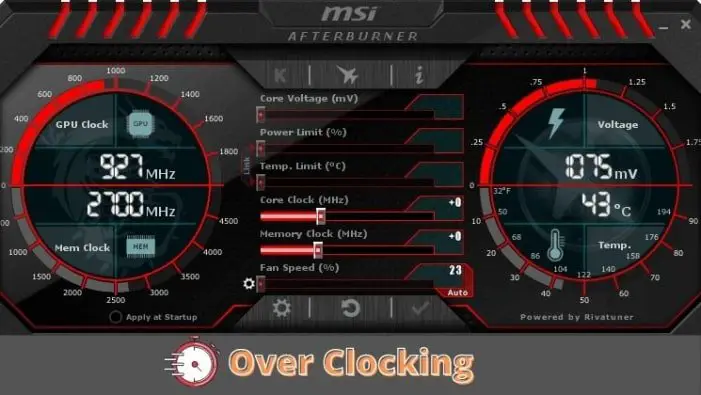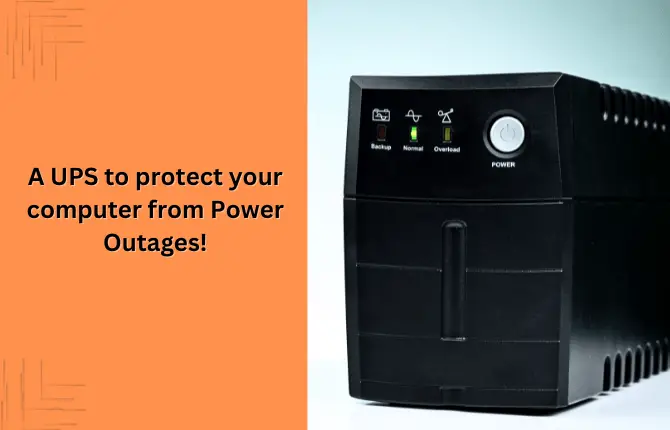I am sure that you have ever heard the term ‘VRM section‘ while reviewing any particular motherboard or graphics card. It is one of the important parts of the motherboard responsible for powering the processor unit which results in the proper functioning of the internal elements and external peripherals of the computer.
Here, I will explain to you ‘What is VRM section in the motherboard? how does it work? what its parts are? and why it is an integral element of the motherboard? for the stability and overclocking of our computer. So, let’s get started.
What is VRM on Motherboard?
The motherboard VRM (Voltage Regulation Module) section is a group of 3 main components i.e MOSFETs, chokes, and capacitors usually located to the left and above the processor socket.
The main function of VRM (Voltage Regulator Module) is to convert the voltage supplied from the power supply into usable voltage for various elements of the motherboard like CPU chip, RAM, slots on circuit board, etc since every component needs a different amount of voltage to function.
Components, as a rule, do not need a whole 12 V. For example, some processing chip needs only 1.5 V.
The second important task for a VRM is to supply this voltage steadily, without surges and drops which can affect the stability of the entire computer. The VRM is nothing more than lowering the voltage value than the original, coming from the power supply unit to the ideal value for a specific component installed in the motherboard that requires it to function properly.
Main Components of VRM Section

In the above image, you can see the architecture of the VRM section (Voltage Regulator Module) made up of three key elements MOSFETs, Chokes, and Capacitors. The voltage before entering into VRM passes through the passage of Diodes and Resistors to ensure that the electric current that arrives does not exceed certain values which can cause heat.
1. MOSFET:
The MOSFET stands for ‘Metal Oxide Semiconductor Field Effect Transistor’ is an insulated gate, basically switches (used to amplify or switch electronic signals). Due to this component, the current passes depending on the signal sent by the PWM controller chip (responsible for managing the power phases and balancing the signals).
They regulate the volume of voltage that the processor needs effectively. The better quality they have, the less heat they will generate and the better the quality and accuracy of the current reaching the processor.
Many manufacturers have concentrated IC controllers with their own MOSFETs in solutions called digital VRM or high-efficiency VRM since concentration allows increasing the number of phases, efficiency, and obviously, the heat given off in these elements, which as it is logically, are quite sensitive to heat, although also, depending on the quality, well prepared to work at high temperatures.
2. Chokes:
Chokes are cubic-shaped (although not always) inductors normally made of metal precisely responsible for converting alternating current signals into lower frequencies or direct current in order to stabilize the voltage that comes out of the MOSFET.
Generally, each choke on a motherboard is a power phase, so the higher the number of phases on a motherboard, the more stable the voltage. The quality of a motherboard depends largely on the quality of these chokes for overclocking.
3. Capacitors:
The capacitors have two main functions. The first is to accumulate electric current and the second is to store and prevent voltage surges and reduce ripple in the electronic circuit. In the modern generation of motherboards, solid-state polymer capacitors have long supplanted electrolytic ones. This is because of the way that polymer capacitors have a longer help life.
In fact: this makes the VRM – not a separate module, but a set of controllers, chokes, and capacitors, which eventually give the necessary current.
For the most part, the whole area of MOSFETs is the one that is usually covered by the large heat sinks that we usually see on motherboards, since it is the component of the entire group that heats up the most.
What are Power phases of a VRM?
The above set of elements are also called in another way as the configuration of power phases. Going through this phase, power is transmitted to the components in the form of a pulse. This means that voltage surges occur at some point in time. These adversely influence the operation of the equipment.
In order to minimize such surges, it is customary to use more than one power phase, but several. It is considered the more of them, the better. More phases can ensure a more extended and more steady activity of powerful processors with high power consumption.
The VRM is typically sold as “8 + 3” or “6 + 2”. The first number indicates the number of phases dedicated to the CPU. While the second usually refers to the phases of the VRM that remain to power different parts of the motherboard, for example, Primary Memories like RAM.
Of course, when the first number is greater than 8, such as “12 + 1”, “18 + 1”, or significantly more, the manufacturer usually uses a device called a doubler. A doubler allows you to multiply the benefit of existing phases without building additional phases on the board. Although not as compelling as fully separated phases, it allows electrical upgrades at a lower cost.
What are the Best VRM Phases?
Modern computers require more than one single phase VRM. This is the reason present-day computers use multiphase VRMs. The phases distribute the energy load over a wider physical area, reducing heat production and stress on components, as well as providing other electrical improvements related to efficiency and cost per part.

From the above diagram, you can see. That the burst of energy of each phase is staggered from the keep going so that as long as just each phase is operating in turn, the total amount of energy won’t ever change. This, in turn, delivers a smooth and reliable source of power – the ‘perfect’ power needed for a CPU to work optimally.
On average, on modern motherboards, the number of voltage equalizing power circuits is from 4 to 8, which is sufficient. It can be 4 + 1, 8 + 2, 6 + 2, 16 + 1… there are as numerous combinations as the manufacturer wants or can install on their motherboards. More is usually better however as you have also seen the quality of the components is important.
Does Overclocking Needs Good VRM Motherboard?

The goal of VRMs is to give a stable power supply to the operation of the processor consistently. In any case, even a basic VRM can offer enough performance to keep a mid-range CPU at stock speeds. The problem can arise when it comes to overclocking, here the quality of the VRM becomes more important.
They are especially significant while overclocking a CPU or GPU and must supply power to the component in a consistent and stable manner. A bad VRM can degrade and limit the performance of the processor to function under load. It can even cause system reboots or hangs, POST error, unexpected stops, particularly when overclocking.
Overclockers should look for quality VRM boards made from reliable components. If your components are cheap, they may not supply enough voltage under load, causing troubleshooting downtime and failure. The most factor elements are the capacitors and the reactors
The level of ripple acting on the processor depends on the number of phases. The more phases, the more stable the voltage, and well as the less current ripple will be. More phases mean more MOSFETs in the circuit, which has a positive effect on temperature performance.
Moreover, the more transistors, the easier it will be to put a high voltage across the cores, which will positively affect overclocking.
Today in VRM it is standard to use an average of 4 to 8 phases. Another thing to consider is whether or not the VRM is protected with heatsinks against high temperatures and overheats, although that doesn’t generally occur, since unpleasant surprises can happen when manufacturers don’t do the designs well.
At last, the main and only drawback, perhaps, is only the high price.
FAQs Related VRMs.
What is VRM in motherboards and graphic cards?
The VRM (Voltage Regulation Module) is an important section installed with several elements like diodes, resistors, MOSFETs, chokes, capacitors, and a PWM controller. The main function of VRM is transforming the electric current (supplied from PSU) into the proper voltage in order to supply the processor.
Is VRM used only in computers?
Not only in computers but VRMs are also used in other electronic devices that require a similar change such as smartphones and tablets, although those of personal computers are the most discussed because VRMs also play a crucial role, as they to a great extent decide the component’s overclocking capacity.
Is overclocking power dependent on the motherboard’s VRM?
The overclocking capability of the processor relies upon the VRM system. In the event that, for example, you want to overclock the percentages, at that point it is significant for you that there is a high end VRM which is usually installed on high end motherboards for overclocking purposes.
How important is VRM cooling?
There is an immediate connection between CPU power consumption and VRM heating. The more the processor consumes, the greater the load on the power circuits, and, therefore, the more they heat up. MOSFETs create a lot of warmth during activity. Therefore, passive cooling is installed on them as a radiator to abstain from overheating and unstable operation. Therefore, passive cooling is installed on them in the form of a radiator to avoid overheating, failure, and unstable operation.
What is the another name of Motherboard VRM?
The motherboard VRM (Voltage Regulation Module) is also known as PPM (processor Power Module).
Conclusion
Now you know what the VRM section is. This is a very vital part of the computer and matters a lot while overclocking that users often don’t focus on. This module can be found both on motherboards and on video cards. The more the number of phases in the VRM, the more stable the hardware will work.
Here are the insights of the ‘VRM Section of the Motherboard‘ ends.




